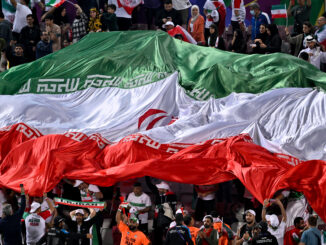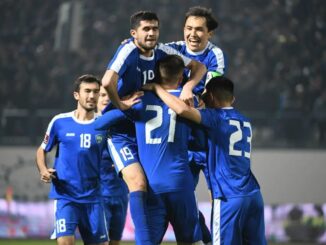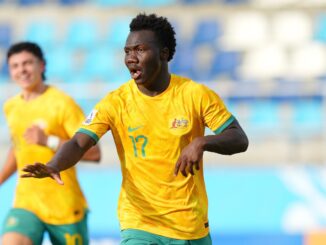
The path to the upcoming AFC Asian Cup 2023 has been far from a smooth one, but after riding the waves of a global pandemic, team withdrawals and a late hosting switch, Thursday’s group stage draw finally arrives to relieve the few years of madness that preceded it.
In a two-part series we’ll look over each pot and how each nation is shaping up ahead of the tournament.
Part One was released yesterday and focused on teams in Pots 1 & 2, while Part Two (below) will focus on Pots 3 & 4.
Tales of transition and frustration
Pot 3 – Bahrain, Syria, Palestine, Vietnam, Kyrgyzstan, Lebanon
The third section of the draw represents the near misses of Asia, teams largely in a state of transition attempting to stabilise after high hopes were broadly deflated in the latter part of World Cup qualification.
This was most notably found in the form of Syria. Once within two matches of qualifying for Russia 2018, and early pacesetters on the Road to 2022, ultimately squad depth, a lack of home hosting and the endless political constraints the country continues to experience, finally caught up with them in a tepid end to World Cup qualification.
A lack of structured competition for a full calendar year hasn’t helped either, and may have been behind the lack of direction that led to the left-field appointment of former Egypt and Uzbekistan coach Hector Cuper in February.
On paper, Cuper offers potential; Syria are blessed with three of the more effective attacking talents at this level of the international game in Mahmoud Al-Mawas, Omar Khribin and Omar Al-Somah. The arrival of a defensively astute coach should sort out the other end of the pitch for them heading into the tournament.
Yet, initial observations tell a tale of a coach in decline since his managerial peak in the early 2000s, in charge of a squad that desperately requires a little rejuvenation, rather than a tactical overhaul. The potential injection of a few new faces plying their trade in Europe may tip the balance, but on the whole they’ll be a team looking back rather than forward in early 2024.
A similar direction is shared by Vietnam. A team built so much in the guise of their former coach Park Hang-seo, that it’s difficult to foresee how they can quickly evolve moving forward, albeit under a consistent and familiar face in former VFF director Philippe Troussier.
Troussier’s second job as U23 coach at the Doha Cup youth tournament in March, and recent Southeast Asian Games, has become the immediate priority, with hope for the upcoming Asian Cup shelved for the timebeing.
While it’s undeniable the current squad is in need of a refresh, their recent run to the Mitsubishi Electric Cup final at the turn of the year, spurred on by the goalscoring form of Ngyuen Tien Linh and the thrust of the energetic right wing back Ho Tan Tai, suggests transition promises not to be a dull affair.
Similarly, transition away from a fixed, comfortable approach is being tackled in Kyrgyzstan; still living in the optimism of heading to only their second Asian Cup, following their debut in 2019.
The speed, however, between narrowly missing out on Round 3 progression in 2021, to only being able to drag themselves over the line in eventual Asian Cup qualification, led to the regrettable move away from Aleksander Krestinin; a man who had come to embody what modern Kyrgyz football looked like.
In his wake, Slovak coach Stefan Tarkovic steps in with a serious job on his hands, having to turn around confidence and reach arguably unrealistic expectations, all in a new country with limited footballing resources.
Reliance on the next generation of talent, in particular focused on the ability of Alimardon Shukurov and Gulzhigit Alykulov may find some immediate bounce, but a quick resolution to the team ethic and philosophy difficulties looks the critical challenge over the coming months.
Another facing change in the dugout, Lebanon have already hit the buffers in the early reign of Aleksandar Ilic. The surprise qualifier for the final rounds of World Cup qualification, the Cedars equipped themselves well against the continent’s elite in remaining compact, well organised, and a threat on the counter.
However, with Ilic’s arrival, the hard work of the last few years seems to be unravelling around him. In a crusade to rejuvenate the squad Ilic has pointedly exiled many of the side’s existing stars, turning to youth over experience, with an increasing focus on the local league.
With three defeats in three matches to start his tenure, Lebanese fans are starting to wonder whether the erratic coach may even be in the post come January.
A contrasting impact has been felt in Palestine, who head into their third consecutive Asian Cup in arguably their best shape in decades under the leadership of Makram Daboub. From a purely defensive and fixed setup, Palestine now look a threat with the ball, and in their transitions.
While there remain some concerns over ageing legs defensively, their attacking play could be one of the real surprise features to look out for in Qatar. Palestine could even boast two of the best Asian talents outside the Big 5 European leagues at the tournament in goalkeeper Rami Hamadeh and winger Oday Dabbagh.
Form and structured preparation, as ever, will be the limiting factors behind Palestine’s push towards the Asian Cup, but with the rejigged schedule seeing guaranteed Asian Cup qualifiers slated in the preceding months, their football might finally have an opportunity to fulfil the undoubted potential.
Similar hopes of hitting their peak at the right time are felt by Bahrain. Now into their fourth year under Helio Sousa’s guidance, the standard of Bahraini football has seen significant improvement over that time. With so much focus put on the team collective, rather than any real stand out individual performer, consistency and that little bit of quality, especially in the final third, does tend to set them back, however.
Embed from Getty ImagesIn colossal striker Abdulla Yusuf, supported by the interplay of Kamil Al-Awad and Jassim Al-Shaikh from deep, Bahrain do have credible experience at international level to be a threat to anyone, if a tad one dimensional.
Whether Sousa will opt to integrate the next generation at this stage, especially looking towards promising centre back Ahmed Bughammar and lively attacker Ibrahim Al-Khatal, January may come a year too soon as Bahrain start to turn their outside attention on an unlikely run at qualifying for the World Cup.
Asia’s developing nations eyeing a surprise
Pot 4 – India, Tajikistan, Thailand, Malaysia, Hong Kong, Indonesia
It’s worth remembering at this point that this will be only the second iteration of the expanded Asian Cup; the bottom pot of teams here wouldn’t have made the draw eight years ago.
While there were credible concerns that expansion to 24 teams would present an uncompetitive group stage that rewarded mediocrity, in promoting third place finishers in a group of four, the immediate impact felt by those who wouldn’t have ordinarily qualified for the tournament, in the likes of Kyrgyzstan and Vietnam, can’t be denied.
Ahead of this year’s draw, the lowest pot offers an opportunity to evaluate the changing face of Asia’s middle order. A set of teams, less content with merely shutting up early and relying heavily on set-pieces. In the main, there is an attacking philosophy, with several exciting talents coming through across Asia.
The perfect examples of this come via the growth from Southeast Asia, with four teams qualifying for Qatar, two of which return for the first time since they hosted the tournament more than 15 years ago.
Malaysia’s qualification campaign was that of ups and downs; from impressive results against dominant neighbours Thailand, to ultimately missing out on the cut for Round 3 due to a mixture of COVID timing and arguably the toughest preliminary stage draw.
Former coach Tan Cheng Hoe oversaw an exciting, if at times carelessly open, approach that unfortunately led to his exit, having crashed out in the group stages of the Suzuki Cup at the end of 2021.
His replacement Kim Pan-gon, while reigning in some of that all-out attack approach, has continued to trust a growing array of forward thinking promising talents. The former Hong Kong coach has since embedded a solid core, with off shoots of brilliance in the form of wide men Faisal Halim, Akhyar Rashid and Safawi Rasid.
Accompanying these, Malaysia have scouted out additions; both from the Malaysian diaspora and foreign-born talent succeeding domestically.
This has proven to be no such guarantee, however. While Dion Cools has shone since coming in to become the team’s leader, the likes of Guilherme de Paula and Liridon Krasniqi haven’t exactly gone to plan.
Months out from a return to the Asian Cup, whether the likes of the newly nationalised Brazilian born pairing Endrick and Paulo Josue complement or disharmonise the squad is one factor to consider.
Another welcome returnee, Indonesia, are also flourishing under their very own South Korean coach. Shin Tae-yong, who aimed to rebuild his reputation following his spell in charge of his homeland at the 2018 World Cup, has in turn released a new generation of players who are hitting their stride at the right time.
Indonesia are another side who prioritise attacking play and trust in youth. The creative ability of Egy Maulana and Witan Sulaeman complement the overlapping runs of wing backs Asnawi Mangkualam and Pratama Arhan, while the stage seems set for the mercurial midfield talents of Marselino Ferdinan to fully blossom on the continental stage for the first time.
Thailand make up the Southeast Asian trio in the lowest pot, and despite having a subdued World Cup qualification campaign, are in a better shape coming out of it under Mano Polking, following their seventh Mitsubishi Electric Cup victory in January.
A similarly evolving and young attacking side, benefitting from the now mature spine of Theerathon Bunmathan, Chanathip Songkrasin and Teerasil Dangda, supplementing rather than carrying the squad, the War Elephants are arguably the most dangerous team to look for at this end of the draw.
From one extreme to the other, concerns remain persistently fixed in India as they head into another Asian Cup with their head coach under pressure to perform above expectations on the continental stage.
While Igor Stimac has in most cases been lucky to hang onto his job thus far, performances against Qatar and Oman in early qualification gave promise that on their day they are still a difficult proposition to breakdown.
The problem, as ever, has been going in the other direction. Following in the footsteps of a more positive coach in Stephen Constandine, Stimac has, some would say out of necessity, since looked to retain solidity rather than experiment with any sort of free flowing ideology.
The squad’s reliance on soon to be 39-year-old Sunil Chhetri is surely in its last days, but the supporting cast for now doesn’t look capable of replacing his goals anytime soon.
Concerns over competing have for now been put to bed for Hong Kong fans, as the territory optimistically returns to the Asian Cup for the first in over 50 years. Following a difficult qualification campaign, disrupted by travel restrictions and player availability, Jorn Anderson steadied the ship in their eventual progression back in June.
Since then, their form has been up and down; possibly lacking the depth of some of their peers and left relying once more on the regular routes to goal in Matthew Orr, Sun Ming-Him and Law Tsz Chun. Yet the prospect of two new ‘recruits’ in newly nationalised Mahama Awal and German based Michael Udebuluzor, provides some intrigue as we edge towards the tournament proper.
The final team in the draw is the competition’s only debutant – an accomplishment that has felt like a long time coming. Tajikistan were one of the most promising stories of qualification, from their early days showings against Japan and Kyrgyzstan under their, in many ways, forming father Usmon Toshev, to their more attuned, expressive style developed of late under the enigmatic Petar Segrt.
The uniquely bizarre approach, assembled by the self-styled “Einstein” Croat coach has won over the Tajik support heading to Qatar, and will undoubtedly be a noticeable talking point throughout the tournament itself.
While a number of their successful youth teams have yet to really transition through, the core of the squad, many of whom were part of the recent successes of domestic champions Istiklol, are starting to reach their peak.
The overlapping Manucheckhr Safarov and goals of Manuchekhr Dzhalilov are two examples of where Tajik football has risen to the occasion on the continental stage to upset the establishment before when the Tajik champions beat Al Hilal in Riyadh back in 2021. Can it possibly happen again?
Listen to The Asian Game Podcast LIVE from Saitama Stadium for the AFC Champions League Final




